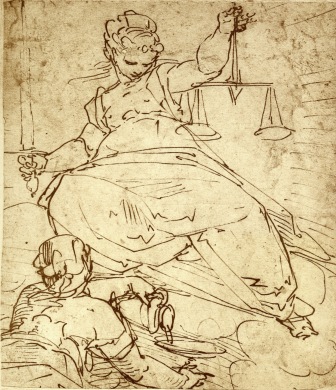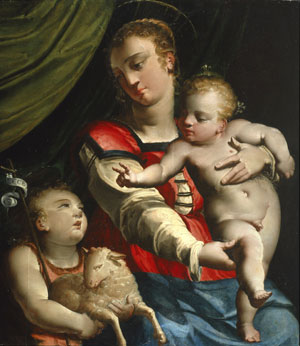Luca Cambiasi (1527-1585)
Get a Cambiasi Certificate of Authenticity for your painting (COA) for your Cambiasi drawing.
For all your Cambiasi artworks you need a Certificate of Authenticity (COA) in order to sell, to insure or to donate for a tax deduction.
Getting a Cambiasi Certificate of Authenticity (COA) is easy. Just send us photos and dimensions and tell us what you know about the origin or history of your Cambiasi painting or drawing.
If you want to sell your Cambiasi painting or drawing use our selling services. We offer Cambiasi selling help, selling advice, private treaty sales and full brokerage.
We have been authenticating Cambiasi and issuing certificates of authenticity since 2002. We are recognized Cambiasi experts and Cambiasi certified appraisers. We issue COAs and appraisals for all Cambiasi artworks.
Our Cambiasi paintings and drawings authentications are accepted and respected worldwide.
Each COA is backed by in-depth research and analysis authentication reports.
The Cambiasi certificates of authenticity we issue are based on solid, reliable and fully referenced art investigations, authentication research, analytical work and forensic studies.
We are available to examine your Cambiasi painting or drawing anywhere in the world.
You will generally receive your certificates of authenticity and authentication report within two weeks. Some complicated cases with difficult to research Cambiasi paintings or drawings take longer.
Our clients include Cambiasi collectors, investors, tax authorities, insurance adjusters, appraisers, valuers, auctioneers, Federal agencies and many law firms.
We perform Luca Cambiasi art authentication, appraisal, certificates of authenticity (COA), analysis, research, scientific tests, full art authentications. We will help you sell your Luca Cambiasi or we will sell it for you.
Luca Cambiasi (surname also written Cambiaso or Cangiagio) was an Italian painter, familiarly known as Lucchetto da Genova. Cambiasi was born at Moneglia, a town in the Genoese state, the son of a painter named Giovanni Cambiasi.

Vanity of Earthly Love 1570’s
Cambiasi was precocious, and at the age of fifteen he painted, along with his father, some subjects from Ovid’s Metamorphoses on the facade of a house in Genoa. In 1544, at the age of seventeen, he was involved in the decoration of the Palazzo Doria, now the Prefettura, perhaps working with Marcantonio Calvi, a painter of his father’s generation. He aided in the vault decoration of the church of San Matteo, in collaboration with Giambattista Castello. His Resurrection and Transfiguration altarpieces for San Bartolommeo degli Armeni date from c. 1560. In 1563, he painted a Resurrection for San Giovanni Battista in Montalto Ligure.

Sketch
This was followed by frescoes for the Villa Imperiale at Genoa-Turalba (also called the Palazzo Imperiali Terralba) with a Rape of the Sabines (c. 1565) and the Palazzo Meridiana (foremerly Grimaldi) (also in 1565). In the Capella Lercari of the Duomo di San Lorenzo, Cambiasi frescoed a Presentation and Marriage of the Virgin in 1569, remainder of chapel by Castello.

Pieta
The 1911 Britannica states that Cambiasi by his 30s began to decline in power, though not at once in reputation, owing to the vexations brought upon him by a passion which he conceived for his sister-in-law. His wife having died, and the sister-in-law had taken charge of his house and children, he failed to procure a papal dispensation for marrying her.

Justice Sketch
In 1583 he accepted an invitation from Philip II to complete for the Escorial a series of frescoes begun by Castello; and the 1911 encyclopedia states the principal reason for traveling to Spain was that he hoped royal influence would gain favor with the Vatican for his marriage plans, but this failed. In the Escorial he executed a Paradise on the vaulting of the church, with a multitude of figures. For this picture he received 2,000 ducats, probably the largest sum that had, up to that time, ever been given for a single work. His paintings in Spain, hew to strict religious thematic.

Christ Led out of Pilate’s House 1570’s
His son Orazio Cambiasi became a painter. Other followers from Genoa, include Giovanni Andrea Ansaldo, Simone Barabino, Giulio Benso, Battista and his brother Bernardo Castello, Giovanni Battista Paggi, Francesco Spezzini, and Lazzaro Tavarone.

Esther and Ahasuerus 1565-1570
Cambiasi had an ardent fancy, and was a bold designer in a Raphaelesque mode. His main influences are said to have been Correggio and the Late Renaissance Venetian school. The artist painted sometimes with a brush in each hand, and with a certainty equalling or transcending that even of Tintoretto.

Madonna and Child 1550
Cambiasi is best represented in Genoa. In the church of San Giorgio is a canvas of the Martyrdom of San Giorgio; in Santa Maria da Carignano, there is a “Pietà,” containing his own portrait and (according to tradition) that of his beloved sister-in-law. Cambiasi is also known for having painted notable nocturnes, including an Adoration of the Shepherds (1570) and the so called Madonna of the Candle (1575). The former painting appears inspired by Corregio’s Nativity.
Still wondering about an Italian painting in your family collection? Contact us…it could be by Luca Cambiasi.
Reviews
1,217 global ratings
5 Star
4 Star
3 Star
2 Star
1 Star
Your evaluation is very important to us. Thank you.
